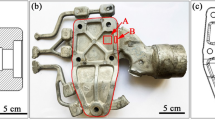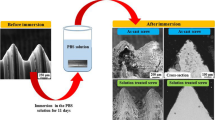Abstract
In the present study, the grain size, second-phase morphology, hardness, water wetting behavior, and corrosion resistance of A205, as a function of solidification time, were investigated. A205 is aluminum–copper alloy that is described in the AA Pink Sheets as “Primarily used for making metal matrix composites” (AA Registration Record Pink Sheets, ISSN: 2377-6722, Footnote 13, Aluminum Association, 2018) and as defined by AMS as a “dilute aluminum/TiB2 metal matrix composite” (AMS D Nonferrous Alloys Committee in Cast aluminum alloy composite 4.6Cu–3.4Ti–1.4B–0.75Ag–0.27Mg (205.0/TiB2/3p-T7P) investment cast, solution, and precipitation heat treated, SAE International, 2014). To study the effect of solidification time, a step sand casting, with varying section thickness, was made and subjected to a modified T7 heat treatment. Optical microscopy, scanning electron microscopy, energy-dispersive X-ray spectroscopy, and X-ray diffraction analysis were utilized to study microstructure, morphology, elemental composition, and phases in the A205 samples, respectively. Potentiodynamic polarization experiment was used to measure the corrosion resistance of the A205 samples. The casting process was also simulated by use of a commercial software. Conclusions drawn from the simulation process show that larger thickness allows for higher solidification time and greater microporosity. It was observed that solidification time has a direct impact on grain size. The phase identification result shows that the two main phases of the alloys are Al and TiB2, while a modified heat treatment cycle makes a complete solution of copper in the grains. Wetting study shows that surface chemistry is not a controlling factor on contact angles, while corrosion result shows a relationship between solidification time and corrosion resistance of the A205 samples. It was observed that there is almost 70% decrease in corrosion rate from the sample with the least section thickness to the sample with the largest section thickness.















Similar content being viewed by others
References
M.B. Djurdjević, Z. Odanović, J. Pavlović-Krstić, Melt quality control at aluminum casting plants. Metall. Mater. Eng. 16(1), 63–76 (2010)
O.N. Senkov, A.P. Druschitz, S.V. Senkova, K.L. Kendig, J. Griffin, Ultra-high strength sand castings from aluminum alloy 7042, in Shape Casting (Wiley, London, 2011), pp. 199–206
G. García-García, J. Espinoza-Cuadra, H. Mancha-Molinar, Copper content and cooling rate effects over second phase particles behavior in industrial aluminum–silicon alloy 319. Mater. Des. 28(2), 428–433 (2007)
J.-H. Cho, S.H. Han, C.G. Lee, Cooling effect on microstructure and mechanical properties during friction stir welding of Al–Mg–Si aluminum alloys. Mater. Lett. 180, 157–161 (2016). https://doi.org/10.1016/j.matlet.2016.05.157
G. Quan, L. Ren, M. Zhou, 2.13 Solutionizing and Age Hardening of Aluminum Alloys, Comprehensive materials finishing (Elsevier, Amsterdam, 2017)
L.Y. Zhang et al., Effect of cooling rate on solidified microstructure and mechanical properties of aluminium-A356 alloy. J. Mater. Process. Technol. 207(1–3), 107–111 (2008)
AA Registration Record Pink Sheets, ISSN: 2377-6722, Footnote 13, Aluminum Association, Oct-2018
AMS D Nonferrous Alloys Committee, Cast Aluminum alloy composite 4.6Cu–3.4Ti–1.4B–0.75Ag–0.27Mg (205.0/TiB2/3p-T7P) investment cast, solution and precipitation heat treated, SAE International (2014)
J.R. Davis, J.R.D. Associates, A.I.H. Committee, Aluminum and Aluminum Alloys. ASM International(1993)
R.N. Wenzel, Resistance of solid surfaces to wetting by water. Ind. Eng. Chem. 28(8), 988–994 (1936)
A. Kordijazi, Optimization of Ni–P–Zn electroless bath and investigation of corrosion resistance of as-plated coatings. Mater. Res. Express 6(9), 096565 (2019)
A. Kordijazi, Electrochemical characteristics of an optimized Ni-P-Zn electroless composite coating. Adv. Mater. Res. 1043, 124–128 (2014)
V. Hejazi, Wetting, superhydrophobicity, and icephobicity in biomimetic composite materials (2014)
J.-Y. Shiu, C.-W. Kuo, P. Chen, C.-Y. Mou, Fabrication of tunable superhydrophobic surfaces by nanosphere lithography. Chem. Mater. 16(4), 561–564 (2004)
R. Ramachandran, M. Nosonovsky, Coupling of surface energy with electric potential makes superhydrophobic surfaces corrosion-resistant. Phys. Chem. Chem. Phys. 17(38), 24988–24997 (2015)
A. Kordijazi, S.K. Behera, O. Akbarzadeh, M. Povolo, P. Rohatgi, A statistical analysis to study the effect of silicon content, surface roughness, droplet size and elapsed time on wettability of hypoeutectic cast aluminum–silicon alloys, in Light Metals 2020 (Springer, Berlin, 2020), pp. 185–193
S. Das, A. Kordijazi, O. Akbarzadeh, P.K. Rohatgi, An innovative process for dispersion of graphene nanoparticles and nickel spheres in A356 alloy using pressure infiltration technique, Eng. Rep., p. e12110
T. Hashimoto, X. Zhang, X. Zhou, P. Skeldon, S.J. Haigh, G.E. Thompson, Investigation of dealloying of S phase (Al2CuMg) in AA 2024–T3 aluminium alloy using high resolution 2D and 3D electron imaging. Corros. Sci. 103, 157–164 (2016)
K.L. Tee, L. Lu, M.O. Lai, Synthesis of in situ Al–TiB2 composites using stir cast route. Compos. Struct. 47(1–4), 589–593 (1999)
I.G. Davies, J.M. Dennis, A. Hellawell, The nucleation of aluminum grains in alloys of aluminum with titanium and boron. Metall. Trans. 1(1), 275–280 (1970)
P. Sahoo, M.J. Koczak, Microstructure-property relationships of in situ reacted TiC/Al–Cu metal matrix composites. Mater. Sci. Eng. A 131(1), 69–76 (1991). https://doi.org/10.1016/0921-5093(91)90345-N
B.D. Cullity, S.R. Stock, Elements of X-ray Diffraction, vol. 3 (Prentice Hall, New Jersey, 2001)
R. Wiedemann, H. Oettel, M. Jerenz, Structure of deposited and annealed TiB2 layers. Surf. Coat. Technol. 97(1–3), 313–321 (1997)
C.E. Lyman, M.J. Carr, Identification of Unknowns. Electron Diffr. Tech. 2, 373–417 (1992)
D.C. Montgomery, G.C. Runger, Applied statistics and probability for engineers (Wiley, London, 2010)
A.B.D. Cassie, S. Baxter, Wettability of porous surfaces. Trans. Faraday Soc. 40, 546–551 (1944)
X.-M. Li, D. Reinhoudt, M. Crego-Calama, What do we need for a superhydrophobic surface? A review on the recent progress in the preparation of superhydrophobic surfaces. Chem. Soc. Rev. 36(8), 1350–1368 (2007). https://doi.org/10.1039/B602486F
S.D. Cramer, B.S. Covino, ASM Handbook Volume 13 Corrosion, ASM Int. Handb. Comm. (1992)
D.R. Lide, CRC Handbook of Chemistry and Physics, 85th edn. (CRC Press, Boca Raton, 2004)
P. Doig, J.W. Edington, The influence of solute depleted zones on the stress-corrosion susceptibility of aged Al–7.2 mass% Mg and Al–4.4 mass% Cu alloys. Proc. R. Soc. Lond. Math. Phys. Sci. 339(1616), 37–47 (1974)
A. Garner, D. Tromans, Direct Observation of Intergranular Corrosion in AI-4 Wt% Cu Alloy. CORROSION 35(2), 55–60 (1979). https://doi.org/10.5006/0010-9312-35.2.55
K. Urushino, K. Sugimoto, Stress-corrosion cracking of aged Al–Cu–Mg alloys in NaCl solution. Corros. Sci. 19(4), 225–236 (1979)
T.D. Burleigh, The postulated mechanisms for stress corrosion cracking of aluminum alloys: A review of the literature 1980–1989. Corrosion 47(2), 89–98 (1991)
Acknowledgements
We acknowledge gratefully the support of the NSF Fundamental Project-1331532 Grant for this work.
Author information
Authors and Affiliations
Corresponding author
Ethics declarations
Conflict of interest
All authors declare no conflict of interest.
Additional information
Publisher's Note
Springer Nature remains neutral with regard to jurisdictional claims in published maps and institutional affiliations.
Rights and permissions
About this article
Cite this article
Kordijazi, A., Weiss, D., Das, S. et al. Effect of Solidification Time on Microstructure, Wettability, and Corrosion Properties of A205-T7 Aluminum Alloys. Inter Metalcast 15, 2–12 (2021). https://doi.org/10.1007/s40962-020-00457-8
Published:
Issue Date:
DOI: https://doi.org/10.1007/s40962-020-00457-8




